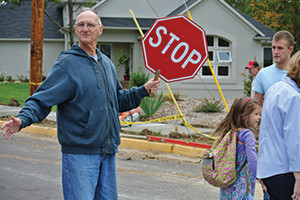With summer drawing to a close, the kids will be back in school in no time. Prepare yourself and your children for a safe and happy school year with these tips on back to school safety for kids.
From safety at the bus stop to avoiding bullying, make sure your child is as best prepared as he or she can be to start the school year with safety in mind.
1) Travel safely to school
By Bus: If your child takes the bus to school, show them in advance where the bus stop is and how to walk safely next to the road or on the sidewalk to reach the bus stop. Explain how to properly wait for the bus, and never to run into the road. They should also never walk behind a bus, only in front once the bus has stopped and they know the driver has seen them.
Walking: Teach kids about crosswalks and to always look both ways before crossing the street. Children who walk to school can also benefit from the buddy system—walking with a sibling or neighbor. Tell children to avoid shortcuts, like cutting through vacant lots. Show them the best route to take, and tell them to take it every day.
By Bike: Children should always wear a bike helmet, and should learn to ride in the direction of traffic. Teach them to stop for traffic lights or stop signs, and to get off their bike and walk it across the street in a cross walk.
Driving: If you drive your child to school, make sure your car seat belts are working. For smaller kids, check to make sure any car seats or booster seats are correctly installed. Never use electronic devices while driving, for safety reasons, and to set a good example.
2) Playground safety
Teach children to look at playground equipment before using it, and show them how to spot broken, cracked, or rusty elements. It’s also good for older kids to learn to be aware of their surroundings on the playground, and to use caution and care playing around younger children.
No matter a child’s age, teach him or her that pushing and shoving, name-calling, and other aggressive behavior will not be tolerated at the playground—or elsewhere.
When your child is going to play, ask him or her to assess their outfit for any loose clothing, jewelry, or scarves, and to remove any potentially hazardous items before playing.

3) Prevent bullying
Talk to your kids about bullying and how it isn’t acceptable to tease, mistreat, hit, or otherwise bully their classmates. Also share with them that it is always best to tell a teacher or other adult if they are bullied, or if they see another child being bullied.
Most important, encourage an open dialogue about bullying, it’s affects, and how to prevent it. Teach your child what to say in order to stick up for themselves, including phrases like, “Hands off my body,” “Stop that,” and “I don’t like being called that.”
Also let kids know that they can walk away from bullying. Most bullying starts with verbal aggression, and depending on how a child responds, escalates. Teach your child to either walk away, or not respond. Most bullies are looking for an emotional response, and will continue the bullying if they get one.
4) Getting home from school
Go over with your child their route home from school, whether it be by bus, car, or on foot. Let your child know it’s never okay to stop somewhere else after school unless it’s a prearranged visit.
It’s always worthwhile to go over rules of talking to strangers in case they are approached on the way to or from school. They shouldn’t go anywhere with a stranger, or accept food or gifts from a stranger. If they see a stranger hanging around, they should tell a trusted adult.
5) Home safety
Once your children are home from school, make sure their domain is a safe one. For older children staying home alone until a parent arrives, go over with them the expectations for their unsupervised time. Make a written list prioritizing homework, chores, and recreational activities.
Set up an area for doing homework that is free from distractions, such as television or electronic devices. Establish rules for use of computers, the Internet, and the television. Leave snacks in the fridge or on the counter to keep kids nourished before dinner.
Talk to children about not answering the door if a stranger appears, and to never bring classmates or acquaintances home after school without first talking to a parent and getting permission.
Looking for more tips on how your kids can stay safe at home? Read these five lifesaving safety skills your child should know.
Whether they’re on the playground, in the classroom, or at home, ensure your child is safe and happy. Communicate these tips on back to school safety for kids to your children and have a great start to the school year.


